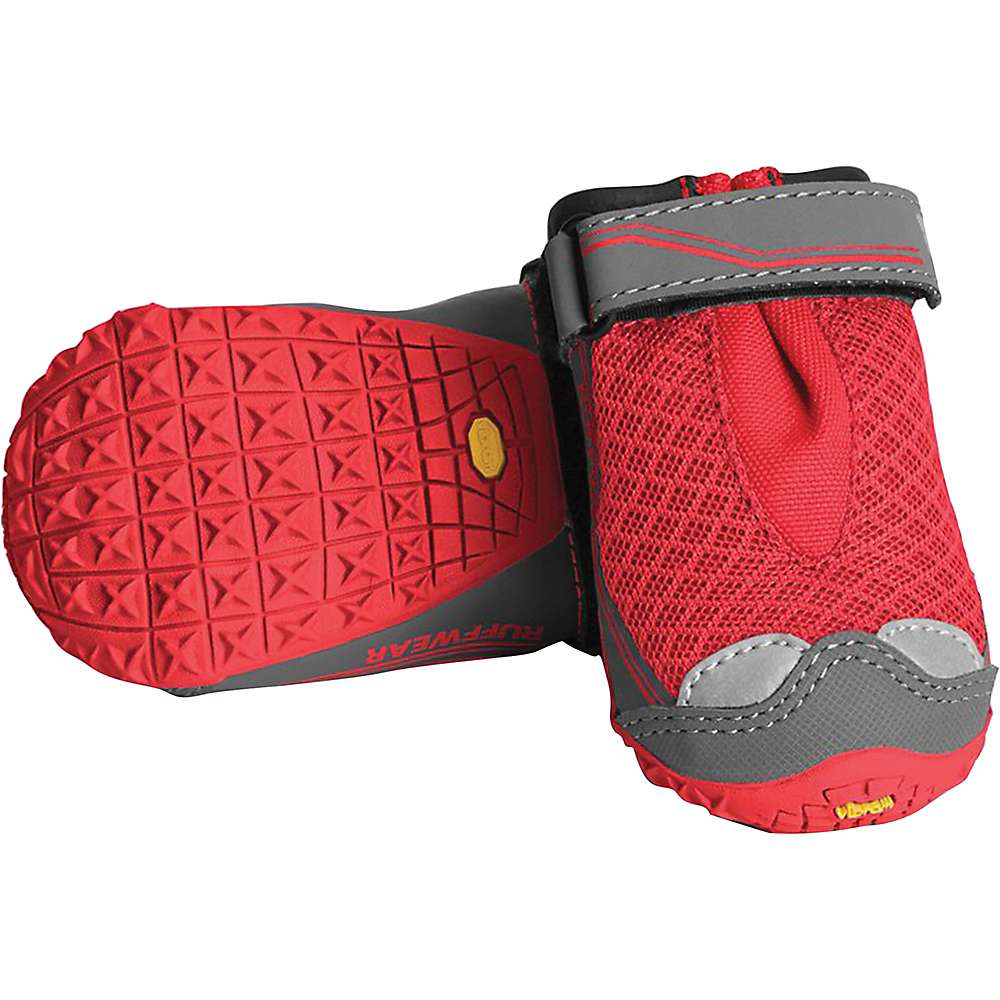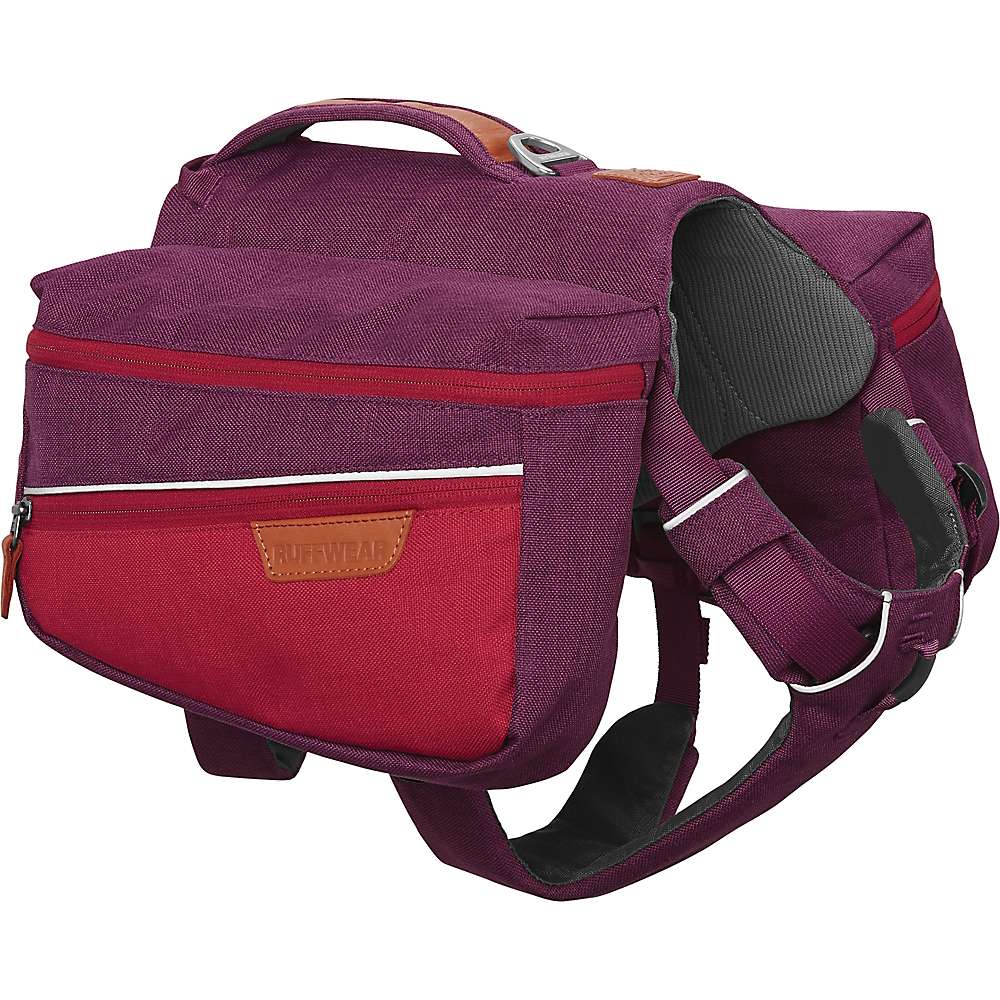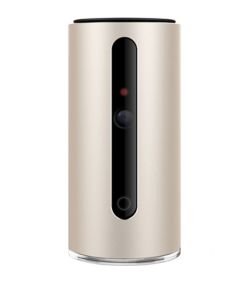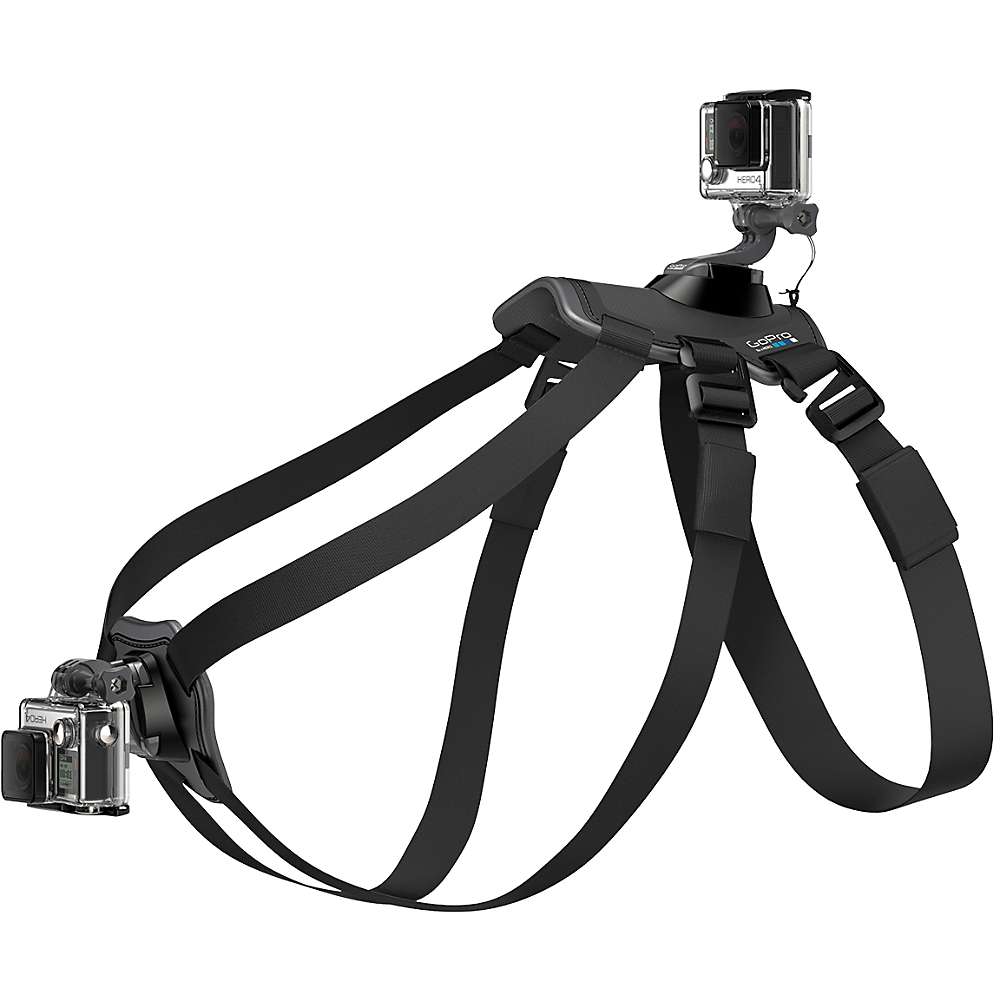Living with a Malamute...
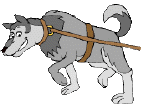
A Malamute is a beautiful and intelligent dog, but with it comes the responsibility to learn about it's uniqueness. Many Malamutes have gone to good, well-meaning homes, only to be abandoned later because they weren't what the buyer expected. A puppy deserves to go to a home that will love him forever. Take the time to learn about this breed and be sure it's what you want BEFORE you buy. Everyone loves the looks of a pretty Malamute, but not everyone can live with one.
Why would someone want one? They have the happy enthusiasm of a quarterback, the pulling power of a locomotive, skulls of steel, most will steal food, raid the trash, chase cats, kill livestock, and snuggle up to the burglar. When shedding, you'll be drinking fur in your morning coffee and wearing it to work. They are the world's greatest diggers and world's worst obedience dogs. But as friend, soul mate and intelligent companion in a close partnership, a dog that adores confident, well-behaved children, the beautiful Alaskan Malamute has no equal.
The socialization done by the breeder before you bring your puppy home is the single most important ingredient to few problems. The training you provide after the puppy is home is the remainder of the recipe. A breeder should take the time to expose the puppy to new situations, people and children. Puppies should be handled often and raised in the home as part of the family, if you expect to take the dog home and have it be part of yours. A breeder may use dogs of good temperament in a breeding program, but if the puppies are not socialized well you may still have problems. A good breeder will raise the pups in clean conditions and begin leash and house training, cuddle and play with the pups often, and stop any aggressive behavior before it gets started.
Once the puppy is in the new home, it is up to the owner to continue the socializing experiences and to teach manners and appropriate behavior through adolescence to adulthood. It will take patience, consistency and a sense of humor!
Some people feel Malamutes do not make good house dogs. Phooey! You are hearing the words of a lazy owner that doesn't want to teach the puppy house manners. Many people keep their Malamutes outdoors - they have the coat for it - but if asked, all would rather be near the family pack, and an unhappy Malamute can be a real nuisance - howling, digging, escaping.
As housedogs they are quiet. Sometimes it seems we don't have any dogs in the house because they all take up residence in a favorite out-of-the-way spot and snooze. They are content to patiently laze around most of the day until those times you take the dog for a long walk or run. Many like to den under a table or in a secluded corner - especially the girls. If an adult-sized crate is introduced properly, it often becomes his favorite "den" when he needs a break from kids and commotion.
Malamutes ordinarily won't follow you around and get underfoot (unless you're making dinner). You'll hardly know he's there unless a visitor comes to the door. He usually won't bark, but will rush to the door and excitedly wait for you to open it so he can say "hi". He will get bored! He'll need to have a toy box of chew hooves, rawhides, balls, booda-bones, and other toys to occupy himself when you are busy or not home. A Malamute will sometimes be destructive to his toys , but a well-stocked toybox will save your furniture and woodwork. Malamutes do just fine in warm weather and warm climates if a cool place (shade, basement, air conditioned home) is available. Ours love to snooze on ceramic tile, block winter drafts coming under the door and lie near a cool toilet in any weather.
![]()
They are WORKING dogs, and are happiest when doing something. You'll need to think of a way to working your Malamute. Your Mal would love to jog with you, pack supplies while hiking, pull a wagon or sled. Some like to swim, play with kids, go ski-jouring, enter weight pulls, run along side a bike on leash, run in a fenced field and do whatever you enjoy doing for exercise. An older dog may be content with intermittent walks or car rides, but a dog less than two or three years old needs to use puppy exuberance constructively.
Malamutes are seasonal shedders. They are either "blowing coat" in abundance or growing it back. You'll want to brush often, down to the skin. Combing with a "rake" or slicker brush every day usually takes only 5-10 minutes and nets a handful of fur. Combing AT LEAST 2-3 times a week is necessary to keep his skin healthy and coat looking good. A wooly coat will need grooming DAILY and may need some gentle trimming to avoid matts. During heavy shedding, combing will need to be done daily to avoid the appearance of "molting". Mals will blow undercoat yearly, twice yearly for unspayed females. Occasionally they will shed even the guard hairs and become almost bald. Nothing can prevent some hair in the house at this stage (see above link). If you comb and vacuum daily much of the hair can be avoided. Malamutes are the King of Dogs, proud, sometimes arrogant, and prefer to look nice.
Malamutes rarely have an odor and try to keep themselves clean. Their fur repels dirt to a large degree, and if they are kept clean from puppyhood (not allowed to dig holes and a regular bath) they usually prefer to stay that way. A dog that is outdoors most of the time will have a thicker, denser coat than a dog that stays mostly indoors. Dogs in northern climates will have thicker coats than dogs in southern climates. If you plan to let your dog live outdoors for long periods after being primarily in the house, you will have to gradually increase the time outdoors to allow him to grow a thicker coat, particularly in the northern climates. Malamutes CAN get hypothermia!
Malamutes do fine in southern climates when they have plenty of shade, water and access to an air conditioned home or basement. They will never grow (or shed) the same thickness of coat their northern relatives will have.
Malamutes, when raised with kids, adore them. They are especially patient with their own. Young children are thought of as littermates, and as puppies they enjoy the play of gentle children. When the puppy gets older, he will find children fascinating and will watch them play for hours, even if he can't join in. Mals are very protective of their own children, sometimes getting between the child and an angry parent! Our puppies have done wonderfully in homes with even very young children, IF the parents take the time to train and are patient and firm. Content to be a TV pillow, play a game of ball, go for a swim, Mals and kids go together extremely well. But they won't be like this without some training! Malamutes are opportunists. A small child and an ice cream cone is a prime opportunity for food theft.
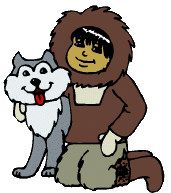 Malamutes are big dogs, and in their joy and
exuberance can knock down a small child. Some Malamutes not raised with
children will be less tolerant of children, especially those outside the immediate
family, and especially if the child is screamy, timid or fearful. Also,
most adult Malamutes regard badly behaved or annoying children as unruly puppies
that need correction, so it's important to supervise and teach children respect
for animals.
Malamutes are big dogs, and in their joy and
exuberance can knock down a small child. Some Malamutes not raised with
children will be less tolerant of children, especially those outside the immediate
family, and especially if the child is screamy, timid or fearful. Also,
most adult Malamutes regard badly behaved or annoying children as unruly puppies
that need correction, so it's important to supervise and teach children respect
for animals.
Expect him to be a puppy a long time. For up to 2 1/2 years some Malamutes can be puppy-like in their desire to chew and get into trouble. So...if you can't watch him, put him somewhere he can't get into trouble, harm himself or your home. Ours like to get into wastebaskets and eat the soap! Mals can be great house dogs and very trustworthy if given their freedom slowly. You can't just leave a puppy alone without teaching the rules and expect him to "obey" while you're gone. Malamutes are very pack-oriented and their separation anxiety can be intense. It's best if someone can be home much of the time while the pup is young, to teach the rules and supervise. Crate training is helpful in making the transition to complete freedom in the house.
![]()
Malamutes love to dig and will need strong corrections and occasional reminders. They enjoy defoliating bushes or gleaning the garden of vegetables (waiting until everything is ripe, of course). They love to hunt and will chase and kill small animals, whether it's the neighbor's small yappy dog, a neighbor cat or a wild rabbit. For this reason you MUST have a fenced yard - as much to keep critters out as to keep the Malamute in. If raised with small animals such as rabbits or birds, it usually will not bother them as long as they are securely caged.
![]()
Malamutes and cats will usually get along just fine as house mates if raised from puppyhood together. It's wise to get the cat first, then add the Malamute rather than the other way around. A Malamute should always be walked ON-leash (no exceptions!), since the urge to chase a squirrel or mouse is irresistible! Traffic sense was not an important survival trait in the arctic! He will will be great at finding "dead things" (from his own hunting or found) in the yard and will probably bring you his treasure to admire, or he'll eat it, or guard it fiercely.
We've been asked if it's a good idea to get two Malamute puppies so they can keep each other company. We feel it is better to get one first, train it well, learn about the breed, and then, when the first is about 2 years old and past the "teen years" get another puppy of the opposite sex. The reasons for this are many, but one of the best is because the first will help you train the second. Their strong pack instincts of wanting to "fit into the pack" will make the youngster emulate everything the older dog does. If he's a brat, the second will be too. If the first has good house manners and respects your alpha-ness, this will rub off on the youngster as well. You will still have to "train" of course, but some of the training will be done by the older dog.
If you have two puppies, they will more closely bond to each other, and may not consider your status as important because they have each other. If they are of the same sex, or siblings with strong personalities, they may fight for dominance. You'll have partners in crime and double the trouble when they go through difficult "puppy" stages such as chewing, challenging your authority, the terrible "2's" at 8-9 months and again at about a year and a half. While they will keep each other company and they will have a willing playmate, they will also be more competitive and jelous for your attention.
An older dog will have established his/her more dominant role and will not feel as threatened when you pay attention to the youngster if you handle situations properly. While an experienced Malamute owner might not have any serious problems raising siblings, an inexperienced owner will make his first mistakes on two dogs instead of one. If you bring a younger dog into a home with an elderly dog, you will have to watch to see that the youngster doesn't bully the senior as it grows up.
![]()
If left outside while you aren't home, he'll need at least a 6 ft. tall, approximately 10 ft. by 10 ft or larger dig proof fenced enclosure, with adequate shade and water. But he'll learn better house manners if he's a house dog full time (going outside to play and potty of course). Malamutes are a prime theft dog, as their use in medical research is highly valued, so any pen used when you aren't home should be lockable. When you are home, a 4 ft. tall fenced yard (unless you are in an area that gets deep snow) with no gaps a puppy can squeeze through is usually adequate, except for the occasional escape artist. Happy dogs rarely jump fences even if they are able to.
Chaining or a trolley system for a dog with the strength of a Malamute is often useless and may cause him to become territorially aggressive and more likely to bite to protect his space. The stress of seeing the squirrel but not being able to chase it can be frustrating. "Invisible" underground "fencing" and electronic collar systems rarely will work for most Malamutes because of their great problem solving intelligence, strong prey drive and high pain threshold. Of course, boundary training will be absolutely useless. Without a fence, at the first opportunity to chase prey, he'll be gone. Malamutes can cover tremendous distances in a short period of time.
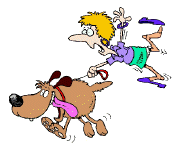
Malamutes love to pull and have wonderful enthusiasm while doing it. An untrained Malamute on a walk will most certainly drag you down the street while you hang on for dear life! They are extremely strong. The weight pull record for one trained and conditioned dog is more than 3,000 lbs.! Therefore, this is not a dog you can expect a 10-year-old to train all by himself.

Malamutes delight in stealing food and raiding the garbage. Possessive behavior toward food and toys is common and must be corrected immediately or the behavior may escalate. It will take training to eliminate this. Their original arctic owners often abandoned them on islands in summer to scavenge and hunt when food was scarce. This trait is still there. If fed a high-quality food, they need less than other breeds of the same size. We breed dogs that are within the Alaskan Malamute Club of America Breed Standard. The correct size for females is 23 inches at the shoulder and 60-75 lbs., and males' 25 inches of approximately 85-95 lbs., although they often seem bigger because of coat. Dogs larger than this often have health problems related to being "giants", and just as human giants don't live very long, neither do abnormally large Malamutes.
Malamutes as a breed are often overfed and under-exercised and often become obese because they seem to always act hungary. That's because they are "world class" moochers and will act like starvation is imminent, if they suspect you'll part with a goodie. This was probably an excellent survival tactic in the frozen north where hunting was scarce.

Malamutes are an independent breed. They will want to please you IF it pleases them first. You will need to attend puppy or obedience classes as soon as possible (3 months isn't too soon). Puppy classes will teach you the basics of positive training methods and will help socialize the pup to other dogs. He needs to learn other dogs can be friends or may become dog aggressive as an adult. It is important a Malamute not be taken from his dam and litter too soon, before 8-9 weeks, since he needs sufficient time to learn "dog manners" from the breeders' adult dogs.
It is normal for a Malamute to always be looking for an opportunity to test your authority. They are experts at "selective hearing" (only hearing the call for a cookie, but not a bath). Consistency is important to a Malamute. Give them an inch, they will gradually take the whole mile! Don't wait till you have a problem to take obedience classes. If you want a dog that will "obey" instantly and without question, DON'T get a Malamute. Growling or sassiness should never be tolerated even in a very young puppy. Sometimes it's difficult to tell a growl from a complaining grumble, but you will learn the difference in time and learn to read your dog. Malamutes are talkers and will tell you just what they think about any person or situation. Often people will think your Malamute growled, when it was only talking. This trait of Malamutes, to talk, is sometimes misunderstood by the general public.
However, Malamutes love to fight with other dogs and any threat (staring, growling, aggressive barking) will be perceived to be a serious invitation to fight for even the gentlest Malamute, and could be fatal for a small dog that initiates the challenge.
![]()
They are all unique and have distinct personalities so it is difficult to generalize. This is not a "cookie cutter" breed. In choosing a puppy, it's best to seek the advice of a knowledgeable breeder for a compatible personality for your lifestyle, rather than deciding arbitrarily on a male, female or specific color. Some are clowns, some very serious, some are easy-keepers, some are intense handfuls, some are aloof, some are cuddly "lap" dogs, some are lazy, some live to pull, some are very active, some calm, most live for food but a few for praise, most won't fetch but a few love playing ball, some love swimming, others want nothing to do with it.
Some will take a like or dislike to certain people (and I've learned to respect their judgement!), and some go so far as to have specific likes and dislikes of other dog breeds. They are loyal to their family, maintaining a unique special relationship with every family member.
All are excellent problem solvers which can be quite frustrating to some owners. In many ways they are like children. They will try to "get around you" when disciplined, will apologize when they've done wrong or "kiss up" when they want something. The males are up to 30% bigger, but their sweet, often gentle personalities often make up for size. A male is more likely to test your authority at puberty, however. Females may be more competitive and jelous around other females but may not test your authority as strongly as a male. And of course, a few never test! Both sexes are calm, affectionate and friendly, interesting and complex.
One interesting characteristic of Malamute puppies is their tendency to look to the owner of the same sex as a role model, following him or her around to learn the family's routine. At puberty both sexes love to intimidate anyone they feel is afraid of them with stares or grumbles. You can have the appearance of a mean dog that really isn't (the Mal was just having fun with the person). Even though their size and look is intimidating to many people, they will not always bark alarm and will never attack intruders. They are awful watch dogs and would gladly invite the burglar in for a bellyrub.

If lonely or upset Malamutes will howl. He may get a brilliant idea and just have to tell you about it! He will "talk" when he needs to tell you something that's on his mind. Every dog in the neighborhood will bark but our Malamutes will watch quietly. However, should a neighbor's dog stray into their perceived territory they will create quite a fuss, even fence fighting with the intruder. People, however, are usually greeted with howls of "Malamute me first!!!". Yet, I have seen our Malamutes, (especially the "alpha" dogs) when they feel a person is threatening, not growl or bark to protect, but quietly put themselves between owner and threat. With a silent rumble, you know they would defend you, their pack member, to the death if it were warranted in the eyes of the Malamute. They will only do this for "their" children, or someone in the pack they respect and love.
![]()
Mature dogs become very dignified as adults (at least some do!) which is usually about 3 years. He will still be friendly and will greet strangers happily, but won't necessarily be playful with persons outside the immediate family. Most will ignore a command given by someone other than a respected pack member (that is, unless a food bribe is offered!). This is a dog that the entire family must be involved in training.
Rarely are they a super-obedient dog. They learn very fast, but only obey when it suits their own self-interest. "Come" is a good example. They may or may not come when you call, but will USUALLY come if they know you are calling for something they enjoy (walk, food, ???). They are easy to train and learn quickly, but don't always feel like doing what they have learned and seem to "forget", especially if THEY feel you are asking them to do something stupid or boring.
The trick to training a Malamute is pure motivation. For centuries they have been bred to THINK and MAKE DECISIONS for themselves which ensured their very survival. You are not going to change them. (Such as whether to disobey and NOT take the sled team over thin ice). Obedience classes help, but if you want a very obedient dog, get a different breed. With Malamutes, training is an ongoing process, the most critical time being the first 6-8 months when he will need much guidance and attention.
They need to be in the general vicinity of the family, although they won't demand your constant attention or petting. A Malamute that wants to play may "hint" by carrying a favorite toy, but won't be a pest. He will greet you enthusiastically whenever you return and there is no greater pleasure than the happy howls of your Mal when you are back with the pack.
Many people feel once they've owned a Malamute they would never want another breed. Everything else is "just a dog", and this includes Rottweilers, Shepherds and other very intelligent breeds. Others would never want one again! You will either love them and their wonderfully complex personalities and superb problem solving intelligence, or feel frustrated by them.
Often people that have other dogs decide they'd like a Malamute. The best companion for a Malamute is another dog of about the same size and opposite sex. (spayed or neutered of course). If spaying or neutering is done early, and the personalities are compatible, same sex dogs can sometimes get along. (But not usually.) Malamute "play" is serious business. Play can get rough and rowdy, with the intent of play always to determine pack order and hierarchy. (One reason you should NEVER wrestle or play a rough game of tug with your Malamute - only EQUALS play like that and YOU must be the alpha).
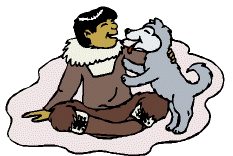
A mellow submissive dog will usually get along with a Malamute because of it's easygoing nature, although you may need to step in and not allow the Malamute to "bully" the submissive dog. Hyper dogs, small yappy or aggressive dogs, large aggressive dogs of the same sex and dogs with dominant personalities can often create major problems. Problems MAY be avoided if the Malamute is brought in as a puppy, but fights are possible when the Malamute reaches adolescence and maturity. Usually the Malamute will try to become the dominant dog in relationships with other dogs in the household.
You must be willing to learn and educate yourself to understand your Malamute. They are beautiful and interesting dogs but they need to respect you and your leadership. By respect I mean fair, firm and consistent corrections. Everyone in the family must agree on the rules and take an active part in his training - anyone that doesn't may be "tested" with growls and challenges. Confident secure adults and children are rarely tested, whereas timid, afraid personalities may be.
Mals have a strong sense of fairness. Although corrections may need to be physical as well as verbal (scruff shakes, pinning) - hitting a Malamute because you're angry or using devices such as pinch collars for training rarely work. They will only make him aggressive and resentful toward you. Hitting a Malamute with a newspaper or yanking on a choke chain is just not effective so you must learn other techniques to correct undesirable behavior such as holding a growling mouth shut with a firm "NO!".
They are also excellent timekeepers. Once you go for a couple of walks at a certain time, feed them at a certain time, they will come to EXPECT you'll do the same thing every time. Sometimes that's a good thing, sometimes not. If you're a person that likes routine, your malamute will help you keep it! If you don't have a set daily routine, soon you will because you'll get tired of "arguing" with your very determined malamute that will remind you that we went for a walk YESTERDAY at this time.
You will use LOTS of positive reinforcement! Learn how a benevolent "alpha" wolf behaves toward his pack-mates and you have the key to a Malamute's heart. You must learn the importance of eye contact. It is NOT a good dog for a timid or inexperienced dog owner. If occasional sassiness or growls intimidate you, don't get a Malamute.
![]()
Although Siberian Huskies do share certain attributes, a Malamute is meant to be a heavy freighting dog and is therefore larger, stronger and heavier boned. Its ears are wider set, always has brown eyes, and its temperament is more relaxed than its foxy-faced Siberian cousin. Siberians are smaller, faster, and used for speed races such as the Iditarod. Many Siberians have blue eyes, a more dominant attitude and are more eager to escape from a fenced yard and can be accepting of strange dogs. Malamutes have endurance, stamina, and great strength for dogs their size. They also have a tendency to be very dog-aggressive. Malamutes are the dogs they take on Antarctic expeditions, pulling great weights for long distances under harsh conditions.
All purebred dogs have some health problems afflicting the breed. The Malamute's main health problems are hip dysplasia and chrondrodysplasia (CHD) more commonly called dwarfism. In chrondrodysplasia, the Kotzebue strain is genetically uninvolved, but there are very few pure Kotzebue dogs today. Hemolytic anemia (blood disorder), hemerlopia (day blindness); corneal dystrophy, progressive retinal atrophy, juvenile cataracts; and renal cortical hypoplasia (a kidney defect) are also known to exist within the breed. Reputable breeders will screen breeding stock for hip and eye disease, and provide CHD probabilities. Gastric torsion (bloat), juvenile cataracts and a condition as yet unnamed but commonly called "coat funk" has recently become a problem in some lines, although how these conditions are transmitted is generally unknown. All reputable breeders will have screened their dogs for eye disorders, hip dysplasia and CHD probability.
A good breeder will ask YOU many questions to ascertain your ability to be a good Malamute owner, and will always take the dog back if you ever can't keep it. Spaying or neutering is the most responsible thing you can do with your Malamute. We did rescue in Michigan for 3 years and the large numbers of unwanted Malamutes (especially 1-2 year olds never taught manners) is heartbreaking.
Spaying or neutering will make your Malamute a better Malamute (females will be less moody and competitive, males less territorial and aggressive). There are more poorly bred Malamutes than there are homes for them. There are breeders who are virtual Malamute puppy mills overproducing these beautiful dogs for a market that has no idea of the challenge they are to live with, and hybrid breeders producing unreliable, often dangerous mixes with Malamute ancestry. Find out where your Mal comes from. It will make a difference in the quality of the family Malamute you bring home.
Woolies ! This is a long-coated Malamute, the longer coat caused by a recessive gene. Most litters will have one or more "woolies" since the trait is in all Malamute lines. It is not preferred in serious sledding or showing the dog, but they make wonderful Malamutes and are even occasionally used in breeding programs to enhance coat. Sometimes they have the best bone and gentlest temperaments in the litter! Although a wooly coat is more maintenance than a normal coat, it may be trimmed for ease of care, and a well groomed wooly Malamute will always get the most attention from passersby because the coat is beautiful. The coat is similar to a Collie's in length and often has a soft texture.
This is to educate and interest you in reading more about Malamutes. They certainly are different from a Beagle or Lab! To own a Malamute you need patience, consistency, and most of all a sense of humor! A well-bred, well-raised Malamute that knows his place in the family pack is a wonderful family dog, loving and friendly.
However, he's easy to ruin as well. Lazy, ignorant owners have ruined more Malamutes than probably any other breed! Every dog deserves a permanent home, so you must decide if you are willing to put the effort and work into training and working with these beautiful and unique dogs. There is no other breed more worthy of the effort!

More information & Helpful links...
Not enough? Want to know more? You should! You can't be too prepared! Here are some other good links about living with Malamutes!

